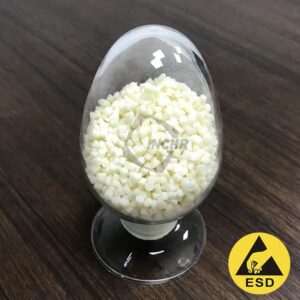Abstract of antistatic agent for plastics
Anti static agent for plastics are additives used to reduce static electricity accumulation on the surface of polymer materials.
It usually has a long molecular chain structure. Its working principle is mainly to reduce the surface resistance by forming a conductive channel or absorbing moisture on the surface of the polymer material, so that static electricity can be dissipated faster and avoid various problems caused by static electricity accumulation, such as dust absorption, electric shock, spark discharge, etc.
Compared with traditional small molecule antistatic agents, permanent antistatic agents for plastics have some advantages, such as long-lasting antistatic effect, not easy to migrate, and less impact on material properties. It is widely used in the field of polymer materials such as plastics, rubber, and fibers to improve the antistatic properties of these materials and improve the quality and safety of products

Types of anti static agent for plastic
1. Polyether polymer antistatic agent: has good compatibility and antistatic properties.
2. Polyester polymer antistatic agent: can effectively reduce surface resistance.
3. Ionic polymer antistatic agent: dissipates static electricity through ion conduction.
4. Amphoteric polymer antistatic agent: has the characteristics of both cations and anions.
Application of anti static agent for plastic
Plastic products: such as various plastic containers, pipes, films, etc., can prevent the accumulation of static electricity and other problems such as dust absorption and electric shock.
Synthetic fibers: used in fiber products such as polyester and nylon to reduce static electricity generation and make fiber products more comfortable to wear.
Rubber products: such as rubber conveyor belts and hoses, etc., to improve their antistatic properties and avoid the dangers caused by electrostatic discharge.
Electronic and electrical fields: used in some plastic electronic component shells, etc., to ensure the stable operation of electronic equipment.
Packaging materials: to prevent packaging materials from absorbing impurities or sticking to each other due to static electricity.
Factors affecting the dosage of anti static agent for plastic
- The dosage of antistatic agents for plastics is usually between 10% and 25%. However, the specific amount added may vary depending on a variety of factors, such as:
- Properties of polymer materials: Different polymer materials may have different sensitivities to static electricity and compatibility with antistatic agents.
- Processing conditions: Processing temperature, humidity, and other conditions may affect the effect and amount of antistatic agent added.
- Requirements for antistatic effect: Depending on the degree of static control required in the application scenario, the amount added may need to be adjusted.
- Presence of other additives: Other additives may be present in the material, and their interaction with the antistatic agent will also affect the amount added.
In practical applications, determining the optimal amount of addition usually requires testing and optimization. The antistatic properties of the material can be tested by gradually increasing or decreasing the amount of antistatic agent added to find the minimum amount of addition that meets the requirements. At the same time, it is also necessary to consider the impact of the antistatic agent on other properties of the material, such as mechanical properties, transparency, etc.




